On January 29, 1974, the San Francisco Chronicle receives a letter from an anonymous writer. He did not sign with his nickname and the crossed circle by which he is known, but there was no need. His style has not changed a bit.
He also utilized his usual blue felt-tip pen.
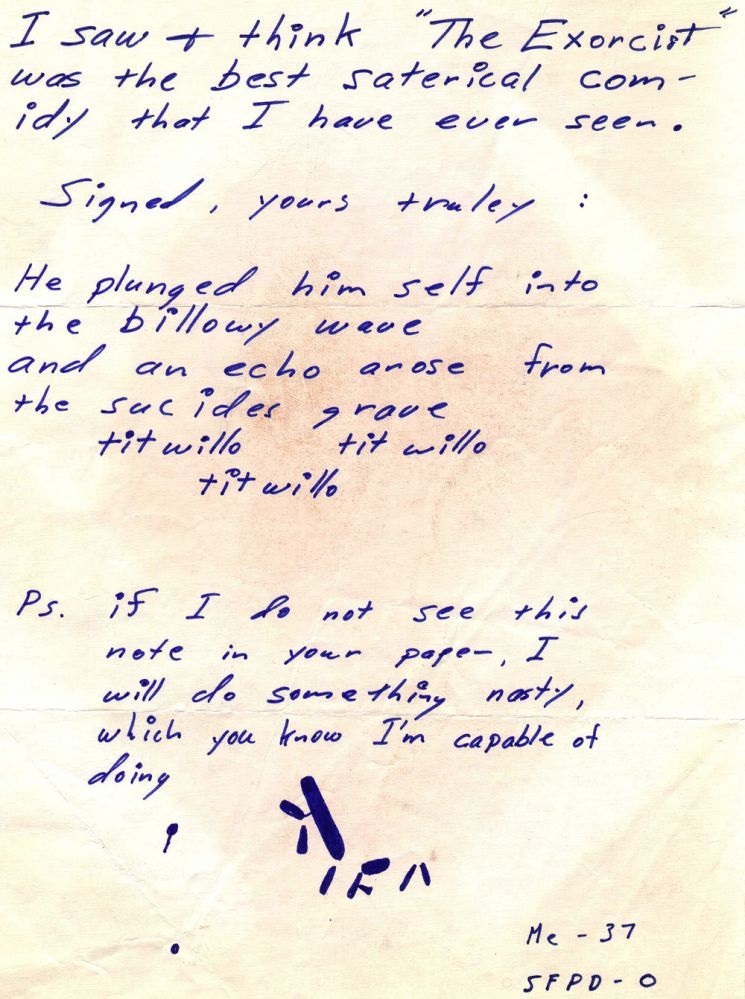
The experts confirms that the note is from from the Zodiac Killer.
He claims to have seen “The Exorcist” (the same movie the Monster of Florence seems to be inspired by in the staging the crime of ’74).
It has been almost three years since he last got in touch with the press. After this letter he will never be heard from again, at least not “officially”.

At the bottom of the note, Zodiac claims to have killed 37 people.
There are also a few strange symbols. It is researcher Kevin Robert Brooks who will figure their meaning out.

The final postscript with Brooks’ solution reads:
"If I do not see this note in your paper, I will do something nasty, which you know I am capable of.
To kill!"
Before the P.S., Zodiac quotes a passage from “The Mikado” by Gilbert and Sullivan. He already paraphrased a few stanzas of the operetta in 1970.
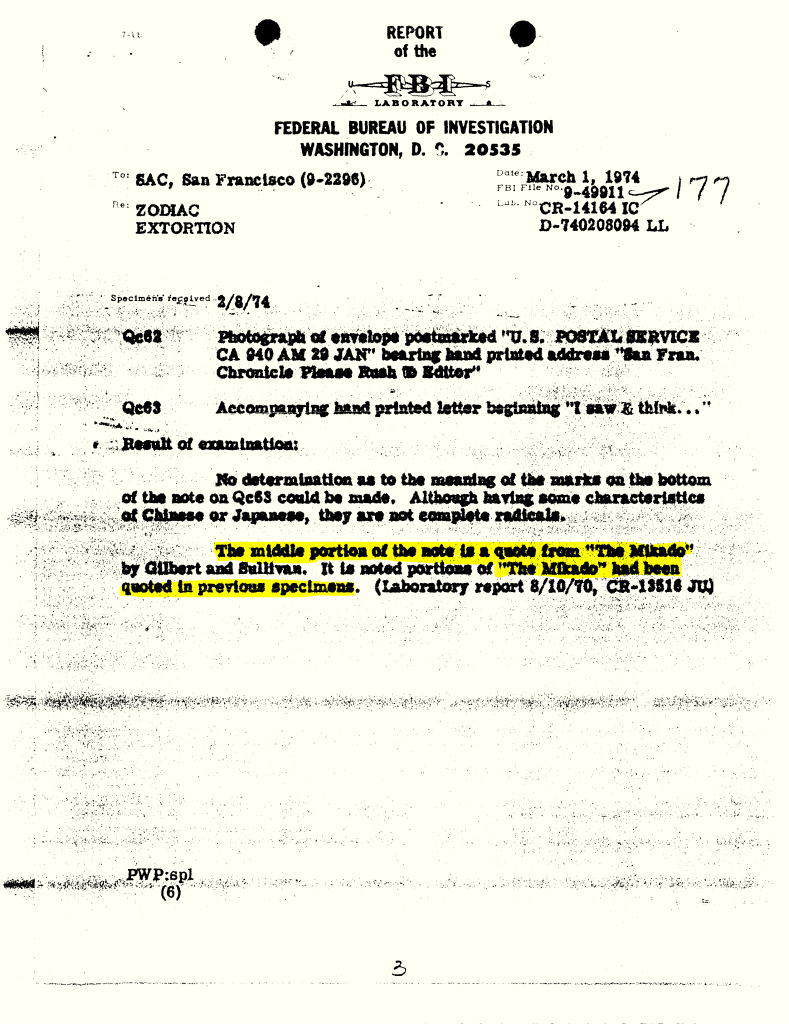
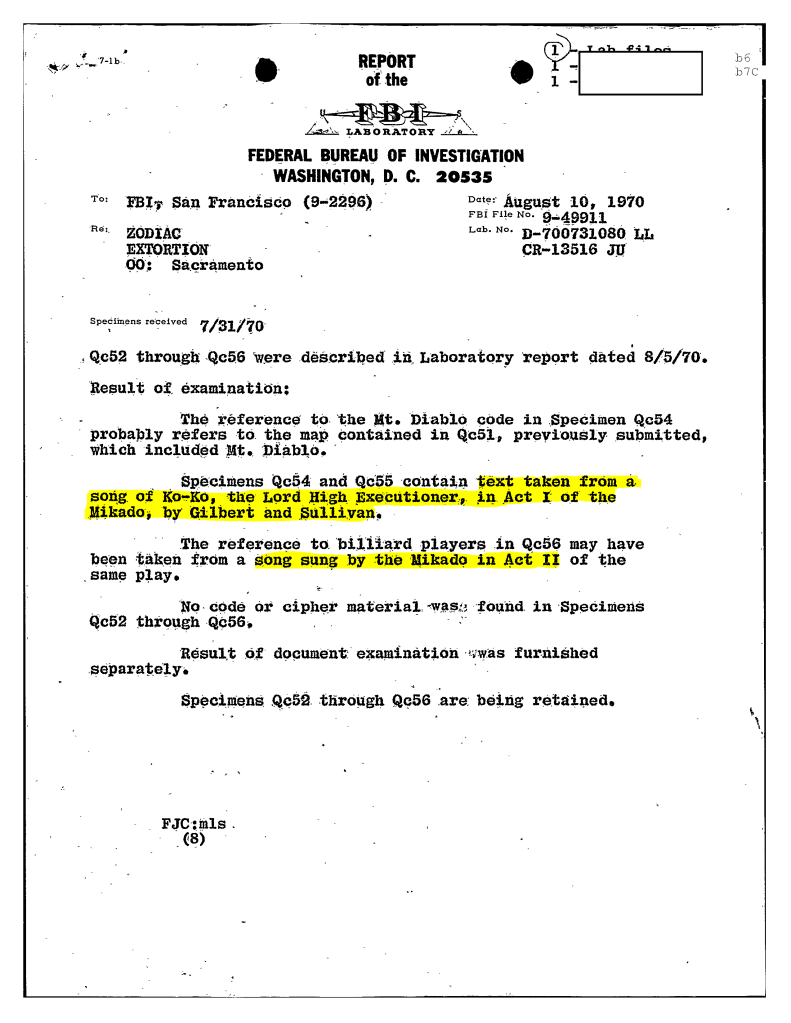
This time he uses an excerpt from it as his signature. What could it mean?

The stanza (explained here) describes the sad end of a bird who sings to attract a partner, but is not reciprocated and in act of desperation throws himself into a wave.
The “suicide’s grave” is the sea in which the protagonist of the story drowns himself.
Below, the performance by actor Mitchell Butel (Opera Australia 2012) makes the meaning of these verses clearer.
These verses are an allusion to Zodiac’s identity, according to a literal interpretation of his words.
The riddle hides his signature.
Zodiac made many references to the water in his crimes and notes.
And this is not the first time he has talked about a drowning.
The letter to Melvin Belli in ’69 reads:

In the next message dated April 20, 1970, quoting (in my opinion) the film “Take the Money and run”, Zodiac informs readers:

Joe Bevilacqua
The latest Zodiac signature is compatible with the surname of the Italian-American Joe Bevilacqua (1935 – 2022), which means “drink the water”.
Bevilacqua was a witness in the trial of Pietro Pacciani on the Monster of Florence’s crimes. He was reported to the police by me in 2018 for an admission of guilt relating to the Monster and Zodiac cases.

Bevilacqua was a US citizen of Italian origin. I wrote a brief bio in this post, sharing several official records.
Between 1974 and 2010, he was an official with the American Battle Monuments Commission, a US government agency responsible for the management of American cemetery and monumental complexes of the World Wars.
Before joining the ABMC, Bevilacqua served 20 years in the Army, working undercover as a criminal investigator with the CID between the ’60s and the ’70s, earning various decorations for valor.
He settled in Florence in July ’74, after his discharge from the Army.
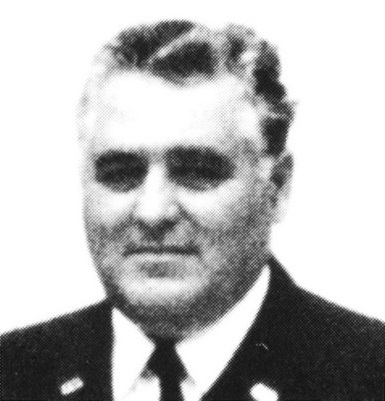
His arrival in the Tuscan city falls within the 7 and a half month interval between Zodiac’s “farewell” and the start of the definite Monster’s homicides, on 14 September 1974.
During the period of the crimes (1974-1985), Bevilacqua lived and worked at the Florence American Cemetery, becoming superintendent in ’77.
The cemetery was located in the main area of the Monster homicides. The last crime scene was 400 meters as the crow flies from Bevilacqua’s home inside the cemetery.

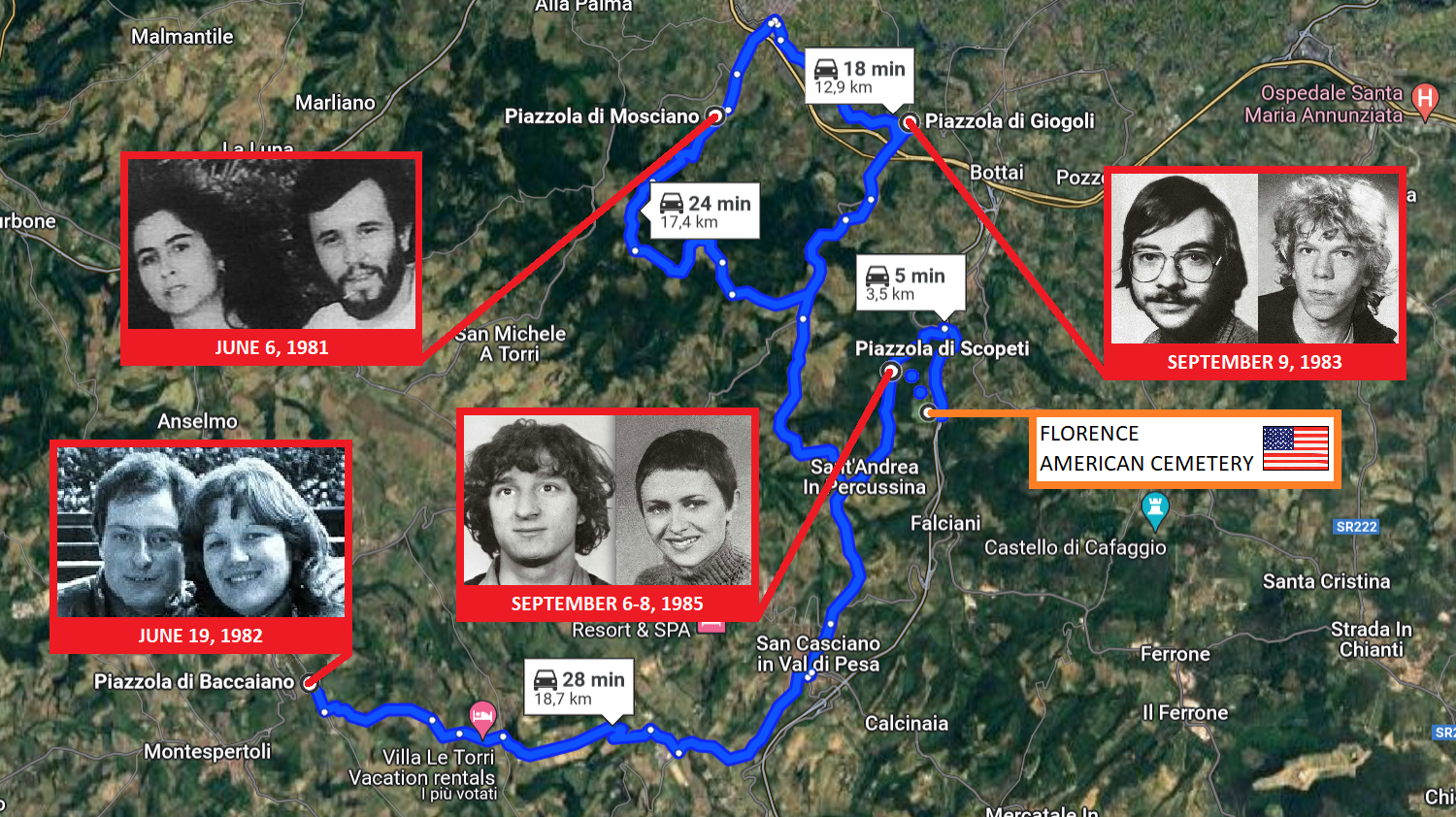
In the early 1990s, Bevilacqua voluntarily contacted the Carabinieri to testify. According to him, he wanted to contribute to the investigation into the Monster.
In his deposition at the Pacciani trial on 6 June 1994, Bevilacqua declared that he had twice seen the Monster’s last victims, two French tourists, camping along Via Scopeti in the days before the attack in ’85. The second time, the couple would find themselves at the future crime scene.
In 2018, Bevilacqua told the Carabinieri that this sighting was from the day before the murders.
The Monster must have noticed the victims in the area where they were attacked in the same span of time.

The conclusion of his interview with the Carabinieri reads:
"I don't remember ever being in Riverside in California but I point out that in the US there are several places called Riverside which means 'by the river'".

Actually, “Riverside” has a slightly different meaning. It means “bank of the river”. Did Bevilacqua make an error on purpose?
The title of the song of “The Mikado” from which Zodiac’s last signature is taken ends with the same expression (only the article changes).
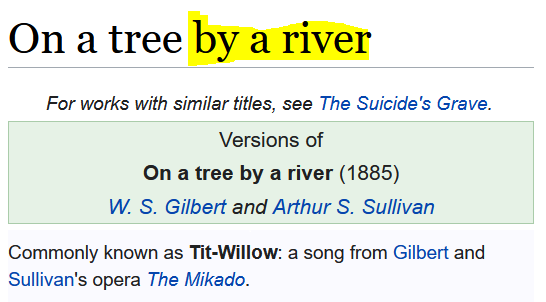
In 2017, Bevilacqua gave me an indication to decrypt the “Zodiac’s name” cipher.
His surname is also consistent with the anagram solution of the last words of the 408 cipher.
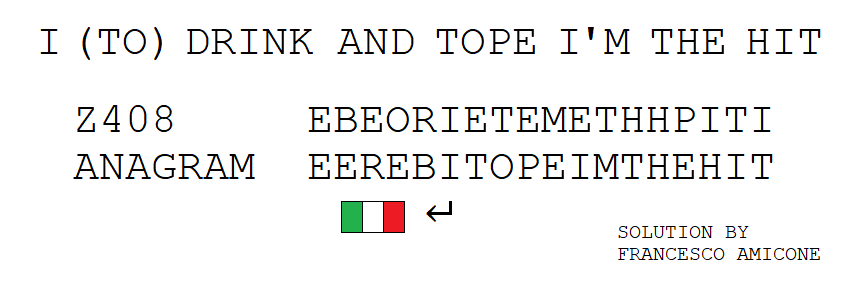
Going back to ’69, one week after the murder of Paul Stine, a new version of “The Mikado” debuted at the Presentantion Theatre, not far from the place where he was killed. It was put on by the Lamplighters, theatrical company known in San Francisco for their representations of Gilbert and Sullivan’s works.
I found out that the theatre was part of the complex managed by the Sisters of the Presentation where the mother of Bevilacqua’s son-in-law went to school until ’64.

Between Bevilacqua and the last definite Zodiac’s letter there is also a possible link concerning the “K” symbol at the bottom of the note (more connections with Zodiac in this post).
Bevilacqua was an CID investigator before retiring from the Army and moving to the Florence American Cemetery.
One of his colleagues who talked about to me in our talks in 2017 was detective Raymond D’Addario.
I wrote about him here.

In 2019, I contacted Lieutenant Colonel Mark L. Reese, Bevilacqua’s battalion commanding officer while serving in Vietnam as an operations and intelligence sergeant in the 27th Infantry Regiment, 25th Division.
In his response (below), Reese states that in September ’68, shortly after being assigned to command of the 1st “Wolfhounds” battalion, the commander of the 25th Division charged Bevilacqua with an undercover investigation.
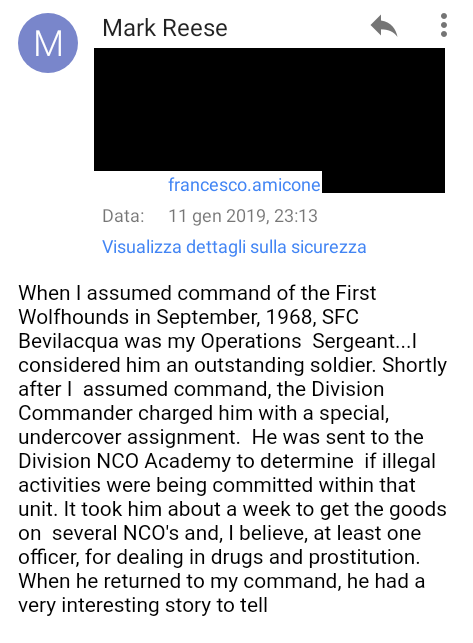

A response to my FOIA request proves that D’Addario was an investigator for the CID unit in the 25th Division of which Bevilacqua was part between August and November ’68.
In my notes taken during the 2017 interviews, I write that Bevilacqua defines him as “chief” (supervisor, I think), linking him not only to Maryland, but also to Saigon and Vietnam.

When Zodiac sent his last “official” letter in January ’74, Bevilacqua’s colleague had recently moved to Santa Rosa, north of San Francisco, it turned out checking on Ancestry.
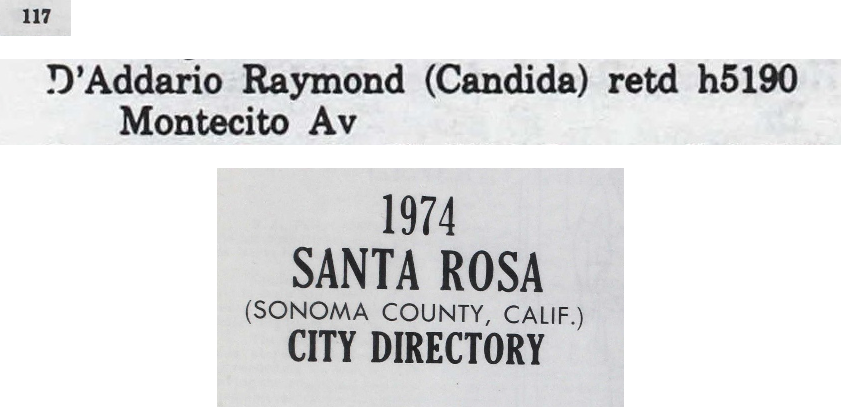
Since decades it is known that the “K” at the bottom of the letter of Zodiac resembles a Chinese character on a barrell belonged to Kim Allen, one of the Santa Rosa hitchhinkers found murdered in the surrounding of the town in the ’70s.
A research on newspapers.com allowed me to verify that the barrel with the symbol was featured on the Santa Rosa Press Democrat and other newspapers from the surrounding of San Francisco in ’72.



You must be logged in to post a comment.